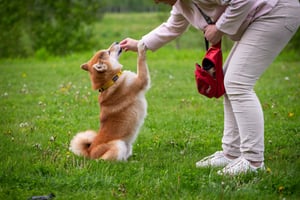Training your dog is a great way to ensure a happy and healthy relationship between your pup and...
Crate Training Your Puppy: The Definitive Guide
Crate training your puppy is a great way to ensure that your pup feels safe, secure, and calm when left alone. This guide will help you understand the basics of crate training and how to make it a successful experience for both you and your pup. We'll cover topics such as introducing your pup to their crate, the best way to crate train, and how to crate train your puppy in a way that is both effective and humane.
Introduction to Crate Training
Crate training your puppy is a great way to help them become comfortable and secure when left alone. It is important to remember that crate training is not intended to be a form of punishment, but rather a tool to help your pup learn how to be alone and to keep them safe when you are away. When done correctly, crate training can help your pup become more independent, secure, and relaxed.
Crate training is also a great way to teach your puppy to go to the bathroom outside. By introducing your pup to their crate and teaching them to wait until they are outside to do their business, you can help them learn proper potty habits right from the start.
How to Introduce Your Puppy to Their Crate
The first step in crate training your puppy is to introduce them to their crate. This can be done by giving them treats or toys when they enter the crate, or simply by making sure that the crate is a pleasant place for them to be. You can also place a blanket or a pillow in the crate for them to lie on.
When introducing your pup to their crate, it is important to make sure that the crate is not too large. A crate that is too big can make it difficult for your puppy to feel safe and secure. Be sure to choose a crate that is just big enough for your pup to stand up, turn around, and lie down in comfortably.
It is also important to make sure that the crate is not too small. A crate that is too small can cause your pup to become anxious and stressed out. Make sure to choose a crate that is just the right size for your pup.
The Best Way to Crate Train Your Puppy
Once your puppy is comfortable in their crate, you can begin the process of crate training. The best way to crate train your puppy is to use positive reinforcement. This means that every time they do something right, such as going to the bathroom outside or staying in their crate, you should reward them with a treat or praise.
It is also important to keep training sessions short and positive. If your pup starts to become frustrated or anxious, take a break and try again later. It is also important to remember to be patient and consistent with your pup. Crate training can take some time, but with patience and consistency, your pup will eventually learn.
It is also important to remember that crate training should never be used as a form of punishment. Your pup should always feel safe and secure in their crate, and any negative associations with their crate can make it difficult for them to learn.
How to Crate Train Your Puppy in a Humane Way
Crate training your puppy in a humane way is essential to ensure that your pup is comfortable and secure in their crate. Here are some tips to help you crate train your puppy in a humane way:
- Make sure that your pup has plenty of space to move around in their crate. A crate that is too small can make your pup feel cramped and uncomfortable.
- Provide plenty of toys and treats. This will help make your pup's crate a pleasant and enjoyable place to be.
- Only use the crate for short periods of time. If your pup is left in the crate for too long, they can become anxious and stressed out.
- Never use the crate as a punishment. Your pup should always feel safe and secure in their crate.
- Be patient and consistent. Crate training can take some time, but with patience and consistency, your pup will eventually learn.
Conclusion
Crate training your puppy is a great way to ensure that your pup feels safe, secure, and calm when left alone. By introducing your pup to their crate and using positive reinforcement, you can help your pup learn how to be alone and to keep them safe when you are away. It is also important to remember to be patient and consistent with your pup, and to crate train your puppy in a humane way. With the right approach, you can help your pup become more independent, secure, and relaxed.



